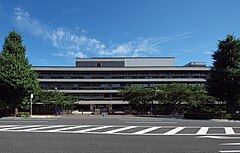
Back Biblioteek van die Japannese Parlement Afrikaans مكتبة البرلمان الوطني Arabic مكتبة اليابان الوطنيه ARZ Biblioteca Nacional de la Dieta AST Японияның милли парламент китапханаһы Bashkir Нацыянальная парламенцкая бібліятэка Японіі Byelorussian Нацыянальная парлямэнцкая бібліятэка (Японія) BE-X-OLD Национална парламентарна библиотека (Япония) Bulgarian नेशनल डायट लाइब्रेरी Bihari Nacionalna parlamentarna biblioteka Japana BS
 Tokyo Main Library of the National Diet Library | |
| Country | Japan |
|---|---|
| Type | National Library, Parliamentary Library |
| Established | 1948 |
| Reference to legal mandate | National Diet Library Law |
| Location | Tokyo, Kyoto |
| Coordinates | 35°40′42″N 139°44′39″E / 35.67833°N 139.74417°E |
| Branches | 27 |
| Collection | |
| Items collected | books, journals, newspapers, electronic archives, manuscripts, official publications, doctoral dissertations, maps, sheet music |
| Size | 41,881,649 items (March 2016)[1] |
| Criteria for collection | Publications issued in Japan, statutes and parliamentary documents, publications on Japan, reference material, material on science and technology, publications of international organizations and foreign governments, children's literature and related material, Asian works |
| Legal deposit | legal deposit |
| Access and use | |
| Access requirements | eighteen years of age or older for the Tokyo Main Library and the Kansai-kan |
| Population served | members of the Diet (722: fixed number as of Feb. 2009) and the general public |
| Other information | |
| Budget | JP¥20,163M (FY2008) (US$221M) |
| Director | Sawako Hanyu (2016)[2] |
| Staff | 908 |
| Website | www |
The National Diet Library (国立国会図書館, Kokuritsu Kokkai Toshokan) is the only national library in Japan. It was established in 1948.[3]
The purpose of the library is to assist members of the Diet of Japan (国会, Kokkai). The library is similar in purpose and scope to the U.S. Library of Congress.

The National Diet Library has two main facilities. One is in Tokyo and the other is in Kyoto. There are also several branch libraries in Japan.
- ↑ "National Diet Library Statistics". 2017. Retrieved 9 September 2017.
- ↑ "Sawako Hanyu appointed new Librarian of the National Diet Library". National Diet Library. Archived from the original on 2016-07-31. Retrieved 2016-12-12.
- ↑ Pincus, Leslie. (2006). "Revolution in the Archives of Memory: The Founding of the National Diet Library in Occupied Japan" in Francis X. Blouin and William G. Rosenberg, eds. Archives, Documentation, and Institutions of Social Memory: Essays from the Sawyer Seminar, p. 382.